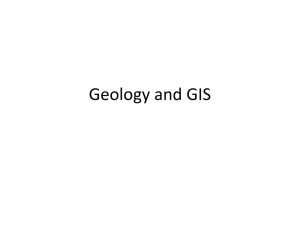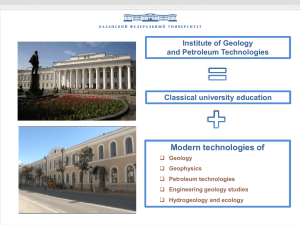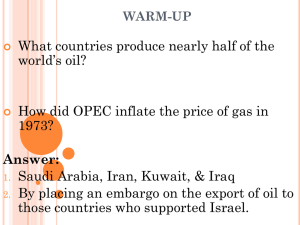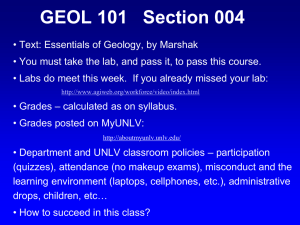4320Lxr10av01Seals - Department of Geology
advertisement
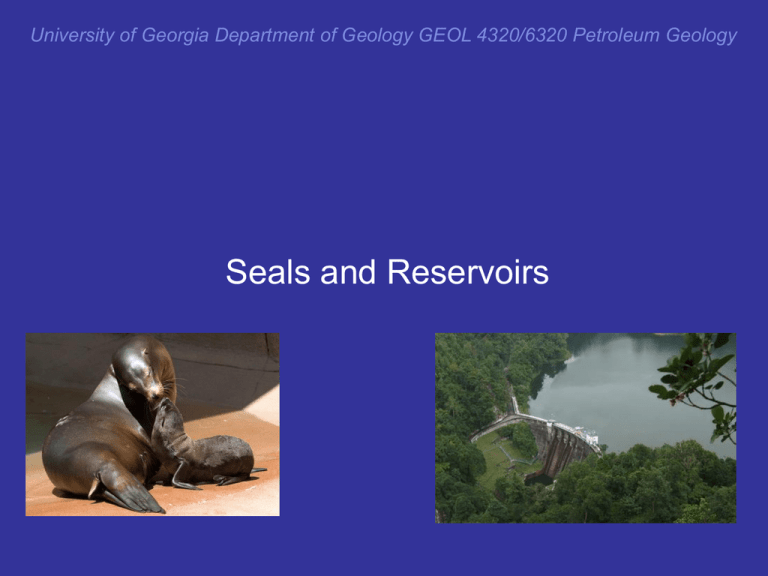
University of Georgia Department of Geology GEOL 4320/6320 Petroleum Geology Seals and Reservoirs University of Georgia Department of Geology GEOL 4320/6320 Petroleum Geology Seals and Reservoirs I. Seals - the simple view Seals are a) ductile (so that they don’t fracture) and b) impermeable (so that fluids can’t pass though) strata The most common seals are shales; the most effective seals are evaporites. Sandstones, on the other hand, are reservoirs and pathways of migration. But what about siltstones? and will all petroleum stop moving at the same permeability barriers? University of Georgia Department of Geology GEOL 4320/6320 Petroleum Geology Seals and Reservoirs I. Seals - the simple view Seals are a) ductile (so that they don’t fracture) and b) impermeable (so that fluids can’t pass though) strata The most common seals are shales; the most effective seals are evaporites. Sandstones, on the other hand, are reservoirs and pathways of migration. But what about siltstones? and will all petroleum stop moving at the same permeability barriers? University of Georgia Department of Geology GEOL 4320/6320 Petroleum Geology Seals and Reservoirs I. Seals - the simple view Seals are a) ductile (so that they don’t fracture) and b) impermeable (so that fluids can’t pass though) strata The most common seals are shales; the most effective seals are evaporites. Sandstones, on the other hand, are reservoirs and pathways of migration. But what about siltstones? and will all petroleum stop moving at the same permeability barriers? University of Georgia Department of Geology GEOL 4320/6320 Petroleum Geology Seals and Reservoirs I. Seals - the simple view Seals are a) ductile (so that they don’t fracture) and b) impermeable (so that fluids can’t pass though) strata The most common seals are shales; the most effective seals are evaporites. Sandstones, on the other hand, are reservoirs and pathways of migration. But what about siltstones? and will all petroleum stop moving at the same permeability barriers? University of Georgia Department of Geology GEOL 4320/6320 Petroleum Geology Seals and Reservoirs I. Seals - the simple view Seals are a) ductile (so that they don’t fracture) and b) impermeable (so that fluids can’t pass though) strata The most common seals are shales; the most effective seals are evaporites. Sandstones, on the other hand, are reservoirs and pathways of migration. But what about siltstones? and will all petroleum stop moving at the same permeability barriers? University of Georgia Department of Geology GEOL 4320/6320 Petroleum Geology Seals and Reservoirs I. Seals - the simple view Seals are a) ductile (so that they don’t fracture) and b) impermeable (so that fluids can’t pass though) strata The most common seals are shales; the most effective seals are evaporites. Sandstones, on the other hand, are reservoirs and pathways of migration. But what about siltstones? and will all petroleum stop moving at the same permeability barriers? University of Georgia Department of Geology GEOL 4320/6320 Petroleum Geology Seals and Reservoirs I. Seals - the simple view Seals are a) ductile (so that they don’t fracture) and b) impermeable (so that fluids can’t pass though) strata The most common seals are shales; the most effective seals are evaporites. Sandstones, on the other hand, are reservoirs and pathways of migration. But what about siltstones and silty shales? But does the nature of the petroleum affect the effectiveness of a potential seal? Will all petroleum stop moving at the same permeability barriers? University of Georgia Department of Geology GEOL 4320/6320 Petroleum Geology Seals and Reservoirs II. Buoyancy and upward migration, or . . . University of Georgia Department of Geology GEOL 4320/6320 Petroleum Geology Seals and Reservoirs II. Buoyancy and upward migration, or The interplay of buoyancy and pore size in determining what is a seal University of Georgia Department of Geology GEOL 4320/6320 Petroleum Geology Seals and Reservoirs II. Buoyancy and upward migration Buoyancy is what drives upward migration of petroleum, and the limit of upward migration is what defines the boundary between reservoir and seal. Upward migration of petroleum through water-filled pores of sedimentary rocks is driven by the “Buoyancy Force”: w = density of water (~1.01-1.10) p = density of petroleum (~0.7-0.8 for oil) Buoyancy Force = h • g • (w-p) h h = vertical extent (height) of the petroleum column h = H = zo = Y in other presentations ~ 0.3 for oil (see above) g = gravitational acceleration University of Georgia Department of Geology GEOL 4320/6320 Petroleum Geology Seals and Reservoirs II. Buoyancy and upward migration Buoyancy is what drives upward migration of petroleum, and the limit of upward migration is what defines the boundary between reservoir and seal. Upward migration of petroleum through water-filled pores of sedimentary rocks is driven by the “Buoyancy Force”: w = density of water (~1.01-1.10) p = density of petroleum (~0.7-0.8 for oil) Buoyancy Force = h • g • (w-p) h h = vertical extent (height) of the petroleum column h = H = zo = Y in other presentations ~ 0.3 for oil (see above) g = gravitational acceleration University of Georgia Department of Geology GEOL 4320/6320 Petroleum Geology Reservoirs and Seals II. Buoyancy and upward migration Buoyancy is what drives upward migration of petroleum, and the limit of upward migration is what defines the boundary between reservoir and seal. Passage of an immiscible fluid through pore throats is limited by the “capillary resistance force” or “capillary injection pressure” or “displacement pressure” inherent in the interaction of fluid and pore throat: = wettability = interfacial tension Resistance = 2• • cos rt rt = radius of pore throat See next page for more explanation. University of Georgia Department of Geology GEOL 4320/6320 Petroleum Geology Passage of an immiscible fluid through pore throats is limited by the “capillary resistance force” or “capillary pressure” or “displacement pressure” inherent in the interaction of fluid and pore throat: = interfacial tension, a measure of the immiscibilty of two liquids because of the cohesion of like molecules in each. If hydrocarbons were soluble in water, this term would go to zero, and resistance would go to zero. Relative to water, gas > light oil > heavy oil. decreases with increasing temperature. = wettability or wetting angle, a rock-dependent term for the extent to which water (or hydrocarbon in some cases) is the fluid on the rock surface. is commonly so small, and thus cos so nearly 1.0, that this term Water is neglected. 2• • cos Resistance = rt Oil Rock rt = radius of pore throat (the smaller the pore throat, the greater the resistance). University of Georgia Department of Geology GEOL 4320/6320 Petroleum Geology Berg (1975) University of Georgia Department of Geology GEOL 4320/6320 Petroleum Geology Berg (1975) University of Georgia Department of Geology GEOL 4320/6320 Petroleum Geology Downey (1984, AAPG Bulletin) University of Georgia Department of Geology GEOL 4320/6320 Petroleum Geology University of Georgia Department of Geology GEOL 4320 Petroleum Geology Implications of the comparison of buoyancy force and displacement pressure: i) Upward migration of petroleum will continue so long as the buoyancy force of a hydrocarbon column exceeds the resistance of the pores in its path. ii) A horizon with pore throats small enough to generate resistance greater than the buoyancy of the hydrocarbon column below it is a seal. The rock below becomes a reservoir rather than a migration pathway. iii) There is a limit to the vertical extent (h or zo) of the hydrocarbon column that any given sealing rock (small-pore-throated rock) can hold. iv) A rock with larger pore throats than those of shale (e.g., a siltstone) can be the seal over a petroleum accumulation of lesser vertical extent. v) Migration through rocks with large pores leaves behind less oil than though rocks with smaller pores where some oil meets blind pathways. vi) Migration of a hydrocarbon column can be limited by generation of petroleum at its base (because separation of the base from its source stops the increase of h and thus stops increase of the buoyancy force). University of Georgia Department of Geology GEOL 4320 Petroleum Geology Implications of the comparison of buoyancy force and displacement pressure: i) Upward migration of petroleum will continue so long as the buoyancy force of a hydrocarbon column exceeds the resistance of the pores in its path. ii) A horizon with pore throats small enough to generate resistance greater than the buoyancy of the hydrocarbon column below it is a seal. The rock below becomes a reservoir rather than a migration pathway. iii) There is a limit to the vertical extent (h or zo) of the hydrocarbon column that any given sealing rock (small-pore-throated rock) can hold. iv) A rock with larger pore throats than those of shale (e.g., a siltstone) can be the seal over a petroleum accumulation of lesser vertical extent. v) Migration through rocks with large pores leaves behind less oil than though rocks with smaller pores where some oil meets blind pathways. vi) Migration of a hydrocarbon column can be limited by generation of petroleum at its base (because separation of the base from its source stops the increase of h and thus stops increase of the buoyancy force). University of Georgia Department of Geology GEOL 4320 Petroleum Geology Implications of the comparison of buoyancy force and displacement pressure: i) Upward migration of petroleum will continue so long as the buoyancy force of a hydrocarbon column exceeds the resistance of the pores in its path. ii) A horizon with pore throats small enough to generate resistance greater than the buoyancy of the hydrocarbon column below it is a seal. The rock below becomes a reservoir rather than a migration pathway. iii) There is a limit to the vertical extent (h or zo) of the hydrocarbon column that any given sealing rock (small-pore-throated rock) can hold. iv) A rock with larger pore throats than those of shale (e.g., a siltstone) can be the seal over a petroleum accumulation of lesser vertical extent. v) Migration through rocks with large pores leaves behind less oil than though rocks with smaller pores where some oil meets blind pathways. vi) Migration of a hydrocarbon column can be limited by generation of petroleum at its base (because separation of the base from its source stops the increase of h and thus stops increase of the buoyancy force). University of Georgia Department of Geology GEOL 4320 Petroleum Geology Implications of the comparison of buoyancy force and displacement pressure: i) Upward migration of petroleum will continue so long as the buoyancy force of a hydrocarbon column exceeds the resistance of the pores in its path. ii) A horizon with pore throats small enough to generate resistance greater than the buoyancy of the hydrocarbon column below it is a seal. The rock below becomes a reservoir rather than a migration pathway. iii) There is a limit to the vertical extent (h or zo) of the hydrocarbon column that any given sealing rock (small-pore-throated rock) can hold. iv) A rock with larger pore throats than those of shale (e.g., a siltstone) can be the seal over a petroleum accumulation of lesser vertical extent. v) Migration through rocks with large pores leaves behind less oil than though rocks with smaller pores where some oil meets blind pathways. vi) Migration of a hydrocarbon column can be limited by generation of petroleum at its base (because separation of the base from its source stops the increase of h and thus stops increase of the buoyancy force). University of Georgia Department of Geology GEOL 4320 Petroleum Geology Implications of the comparison of buoyancy force and displacement pressure: i) Upward migration of petroleum will continue so long as the buoyancy force of a hydrocarbon column exceeds the resistance of the pores in its path. ii) A horizon with pore throats small enough to generate resistance greater than the buoyancy of the hydrocarbon column below it is a seal. The rock below becomes a reservoir rather than a migration pathway. iii) There is a limit to the vertical extent (h or zo) of the hydrocarbon column that any given sealing rock (small-pore-throated rock) can hold. iv) A rock with larger pore throats than those of shale (e.g., a siltstone) can be the seal over a petroleum accumulation of lesser vertical extent. v) Migration through rocks with large pores leaves behind less oil than though rocks with smaller pores where some oil meets blind pathways. vi) Migration of a hydrocarbon column can be limited by generation of petroleum at its base (because separation of the base from its source stops the increase of h and thus stops increase of the buoyancy force). University of Georgia Department of Geology GEOL 4320 Petroleum Geology Implications of the comparison of buoyancy force and displacement pressure: i) Upward migration of petroleum will continue so long as the buoyancy force of a hydrocarbon column exceeds the resistance of the pores in its path. ii) A horizon with pore throats small enough to generate resistance greater than the buoyancy of the hydrocarbon column below it is a seal. The rock below becomes a reservoir rather than a migration pathway. iii) There is a limit to the vertical extent (h or zo) of the hydrocarbon column that any given sealing rock (small-pore-throated rock) can hold. iv) A rock with larger pore throats than those of shale (e.g., a siltstone) can be the seal over a petroleum accumulation of lesser vertical extent. v) Migration through rocks with large pores leaves behind less oil than though rocks with smaller pores where some oil meets blind pathways. vi) Migration of a hydrocarbon column can be limited by generation of petroleum at its base (because separation of the base from its source stops the increase of h and thus stops increase of the buoyancy force). University of Georgia Department of Geology GEOL 4320 Petroleum Geology Implications of the comparison of buoyancy force and displacement pressure: i) Upward migration of petroleum will continue so long as the buoyancy force of a hydrocarbon column exceeds the resistance of the pores in its path. ii) A horizon with pore throats small enough to generate resistance greater than the buoyancy of the hydrocarbon column below it is a seal. The rock below becomes a reservoir rather than a migration pathway. iii) There is a limit to the vertical extent (h or zo) of the hydrocarbon column that any given sealing rock (small-pore-throated rock) can hold. iv) A rock with larger pore throats than those of shale (e.g., a siltstone) can be the seal over a petroleum accumulation of lesser vertical extent. v) Migration through rocks with large pores leaves behind less oil than though rocks with smaller pores where some oil meets blind pathways. vi) Migration of a hydrocarbon column can be limited by generation of petroleum at its base (because separation of the base from its source stops the increase of h and thus stops increase of the buoyancy force). Conventional wisdom says that sandstones are reservoirs and shales are seals, but the points above suggest that • even the lousiest potential seal can be the seal of a short column of hydrocarbons (ii & iv), and • even the best siliciclastic seal (the tightest shale) will fail to seal a tall column of hydrocarbons (i and iii), especially light hydrocarbons. University of Georgia Department of Geology GEOL 4320 Petroleum Geology Implications of the comparison of buoyancy force and displacement pressure: i) Upward migration of petroleum will continue so long as the buoyancy force of a hydrocarbon column exceeds the resistance of the pores in its path. ii) A horizon with pore throats small enough to generate resistance greater than the buoyancy of the hydrocarbon column below it is a seal. The rock below becomes a reservoir rather than a migration pathway. iii) There is a limit to the vertical extent (h or zo) of the hydrocarbon column that any given sealing rock (small-pore-throated rock) can hold. iv) A rock with larger pore throats than those of shale (e.g., a siltstone) can be the seal over a petroleum accumulation of lesser vertical extent. v) Migration through rocks with large pores leaves behind less oil than though rocks with smaller pores where some oil meets blind pathways. vi) Migration of a hydrocarbon column can be limited by generation of petroleum at its base (because separation of the base from its source stops the increase of h and thus stops increase of the buoyancy force). Conventional wisdom says that sandstones are reservoirs and shales are seals, but the points above suggest that • even the lousiest potential seal can be the seal of a short column of hydrocarbons (ii & iv), and • even the best siliciclastic seal (the tightest shale) will fail to seal a tall column of hydrocarbons (i and iii), especially light hydrocarbons. University of Georgia Department of Geology GEOL 4320 Petroleum Geology Scan Selley p. 175 or Berg original Selley 1998 University of Georgia Department of Geology GEOL 4320 Petroleum Geology Gluyas & Swarbrick 2004 University of Georgia Department of Geology GEOL 4320 Petroleum Geology Scan G&S p. 145 Gluyas & Swarbrick 2004 A better caption: Maximum vertical extent of a gas or oil column (horizontal axis) as a function of depth (vertical axis) for a given mudstone or shale seal. Greater columns are possible for oil than gas because of greater buoyancy of gas, so that gas columns overcome resistance of small pore throats. Shapes of curves depend on interplay of (1) decrease of interfacial tension with increasing temperature at depth, (2) decrease of oil density with increasing temperature at depth, and (3) decreasing size of pore throats in mudstone with increasing depth. University of Georgia Department of Geology GEOL 4320 Petroleum Geology • Migration through finingupwards sandstones leaves oil scattered in pore throats; migration through coarsening-upwards sandsandstones leave behind less oil. University of Georgia Department of Geology GEOL 4320 Petroleum Geology • Reservoir pore water, with zero interfacial tension against seal pore water, can escape upwards out of a petroleum as the trap fills. • Gas, with its greater buoyancy than, can escape upwards out of a trap that holds oil. Cant, 1986, AAPG Bulletin 70: 155-160. University of Georgia Department of Geology GEOL 4320 Petroleum Geology • Reservoir pore water, with zero interfacial tension against seal pore water, can escape upwards out of a petroleum as the trap fills. • Gas, with its greater buoyancy than, can escape upwards out of a trap that holds oil (hence “gas chimneys”). Cant, 1986, AAPG Bulletin 70: 155-160. University of Georgia Department of Geology GEOL 4320 Petroleum Geology III. Faults - seals or pathways of migration? A. Faults as zones rather than planes B. Factors favoring faults as seals 1) Abundance of clay/shale along fault Clay smear” or “Shale smear” 2) Faulting early in burial history “Clay smear” vs. “Shale smear” vs. “Shale Gouge” 3. Greater time between faulting and arrival of petroleum Infilling/cementing minerals block open volumes University of Georgia Department of Geology GEOL 4320 Petroleum Geology Shepherd 2009 University of Georgia Department of Geology GEOL 4320 Petroleum Geology University of Georgia Department of Geology GEOL 4320 Petroleum Geology III. Faults - seals or pathways of migration? A. Faults as zones rather than planes B. Factors favoring faults as seals 1) Abundance of clay/shale along fault “Clay smear” or “Shale smear” 2) Faulting early in burial history “Clay smear” vs. “Shale smear” vs. “Shale Gouge” 3. Greater time between faulting and arrival of petroleum Infilling/cementing minerals block open volumes University of Georgia Department of Geology GEOL 4320 Petroleum Geology University of Georgia Department of Geology GEOL 4320 Petroleum Geology Aydin & Eyal 2002 AAPG Bulletin University of Georgia Department of Geology GEOL 4320 Petroleum Geology van der Zee et al. www.ged.rwth-aachen.de/Ww/projects/faults/Clay%20injection/Clay%20injection.html University of Georgia Department of Geology GEOL 4320 Petroleum Geology University of Georgia Department of Geology GEOL 4320 Petroleum Geology Several statistical algorithms are being used in practice for the purpose of estimating the distribution and relative amount (percentage) of shale along fault zones in the subsurface and the associated sealing (Yielding et al., 1997; Skerlec, 1999). . . . The general conclusions from these statistically based methods are that 1) thicker shale beds produce thicker shale smears 2) the percentage of shale decreases with distance from the [shale] source layer, and 3) the relative percentage of shale [in the fault gouge/smear] increases with the number of [shale] source beds passing a point on the fault plane. Koledoye et al. 2003, AAPG Bulletin University of Georgia Department of Geology GEOL 4320 Petroleum Geology Shepherd 2009 University of Georgia Department of Geology GEOL 4320 Petroleum Geology Shepherd 2009 University of Georgia Department of Geology GEOL 4320 Petroleum Geology III. Faults - seals or pathways of migration? A. Faults as zones rather than planes B. Factors favoring faults as seals 1) Abundance of clay/shale along fault “Clay smear” or “Shale smear” 2) Faulting early in burial history “Clay smear” vs. “Shale smear” vs. “Shale Gouge” 3. Greater time between faulting and arrival of petroleum Infilling/cementing minerals block open volumes University of Georgia Department of Geology GEOL 4320 Petroleum Geology III. Faults - seals or pathways of migration? A. Faults as zones rather than planes B. Factors favoring faults as seals 1) Abundance of clay/shale along fault “Clay smear” or “Shale smear” 2) Faulting early in burial history “Clay smear” vs. “Shale smear” vs. “Shale Gouge” 3. Greater time between faulting and arrival of petroleum Infilling/cementing minerals block open volumes University of Georgia Department of Geology GEOL 4320 Petroleum Geology Selley 1998 University of Georgia Department of Geology GEOL 4320/6320 Petroleum Geology University of Georgia Department of Geology GEOL 4320/6320 Petroleum Geology Sources White sans-serif Helvetica text Light gray Times New Roman text Asquith and Krygowski 2004 Assaad 2008 AAPG Basic Well Log Analysis course notes Baker-Hughes Atlas of Log Responses Small white text Bjørlykke 2010 Conaway 1999 Crain’s Petrophysical Handbook Title Glover’s Petrophysique Gluyas & Swarbrick 2004 North 1980 Jonathan B. Martin UF class notes Rigzone Schlumberger Log Interpretation P&I Schlumberger Oilfielld Glossary Shell Petroleum Handbook (1983) Shepherd 2009 Notes Selley 1998 Tissot & Welte (1984) Wikipedia Selley 1978, Porosity gradients in North Sea oil-bearing sandstones: Jo. Geol. Soc. London v. 135, 119-132.
